Patient safety is a crucial aspect of healthcare that demands our attention and continuous improvement.
Recently, a team from RLDatix attended an enlightening workshop session at the International Forum for Quality & Safety in Healthcare titled “Rewiring our approach to safety: Building capacity for patient safety with patients,” participants engaged in thought-provoking discussions about the challenges and opportunities surrounding patient safety.
In this reflection blog post, we will delve into the key insights and ideas shared during the workshop, aiming to shed light on the importance of collaboration, proactive measures, and patient involvement in ensuring safer care.
Measuring Safety: Beyond Harm
One of the central themes that emerged from the workshop was that in care, the absence of harm does not necessarily indicate the presence of safety.
The audience voiced concerns about the overwhelming amount of data available and the difficulty in measuring safety accurately.
We concluded that a reliable approach to determine how safe patient care truly is, is lacking from the process of care, and it became evident that a more comprehensive framework is needed to assess patient safety effectively.
It is not the lack of data availability, more so the way in which data can be used most effectively to support the determination of patient safety.
Introducing the Measurement and Monitoring of Safety Framework
To address the challenges in measuring safety, the workshop highlighted a valuable resource, the Measurement and Monitoring of Safety Framework.
This framework covers five key dimensions that contribute to a holistic understanding of patient safety: past harm, reliability, sensitivity to operations, anticipation and preparedness, and integration and learning.
By examining each of these dimensions, with questions such as “has patient care been safe in the past?” or “are our clinical systems and processes reliable?”, healthcare organisations can gain insights into their safety practices, identify areas for improvement, and proactively enhance patient outcomes.
The Burden of Checklists and Complexity
During a discussion part of the workshop, a conversation unfolded around the topic of checklists and their impact on patient safety.
While checklists serve as valuable tools for standardising care and preventing errors, concerns were raised by a clinician about the excessive number of procedures and processes for staff to follow when delivering care.
This administrative burden often causes strain to the caregiver, detracting from their capacity to provide valuable patient interaction and undermining the essence of quality care.
Empowering a Culture of Safety
One conclusion from the group discussion emphasised the need for a shift in perspective regarding patient safety; exploring alternative approaches to improve patient outcomes, focusing on empowering healthcare professionals, and promoting a safe environment for both patients and providers.
Ideas such as encouraging the reporting of near misses, analysing the role of luck versus process, and simplifying complex systems were highlighted as potential strategies for fostering a culture of safety.
Amplifying the Patient Voice
Recognising the essential role of the patient voice in ensuring safety, the workshop participants emphasised the importance of creating a safe space where patients and caregivers can express their emotions and feel genuinely heard.
Encouraging patients to actively participate in their care and empowering them to speak up about their concerns were deemed vital steps towards improving patient safety.
Conclusion
The workshop session “Rewiring our approach to safety: Building capacity for patient safety with patients” provided valuable insights into the complexities and opportunities surrounding patient safety.
It underscored the need for a proactive, collaborative approach to measure and enhance safety practices.
A culture of safety that prioritises patient outcomes can be fostered by embracing a comprehensive framework, empowering healthcare professionals, and amplifying the patient voice.
As we continue to rewire our approach to safety, let us remember that the quest for improved patient safety requires continuous reflection, innovation, and a collective commitment, from not only healthcare providers, but organisations such as RLDatix to support in the provision of the best care possible.





